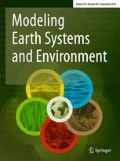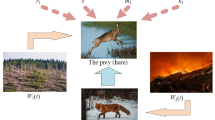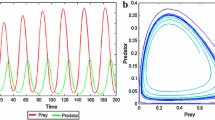Abstract
A mathematical model of predator–prey system is studied analytically as well as numerically. The objective of this paper is to study systematically the dynamical properties of a modified Leslie–Gower predator–prey model with Holling type III functional response. We discuss different types of system behaviours for various parameter values. The essential mathematical features of the model with regard to the boundedness, stability and persistence have been carried out. Some numerical simulations are carried out to support our theoretical analysis. All the results are expected to be of use in the study of the dynamic complexity of ecosystem.


Similar content being viewed by others
References
Ali N, Chakravarty S (2015) Stability analysis of a food chain model consisting of two competitive preys and one predator. Nonlinear Dyn 82(3):1303–1316
Ali N, Haque M, Venturino E, Chakravarty S (2017) Dynamics of a three species ratio-dependent food chain model with intra-specific competition within the top predator. Comput Biol Med 85:63–74
Aziz-Alaoui MA (2002) Study of a Leslie–Gower-type tritrophic population model. Chaos Solitons Fractals 14(8):1275–1293
Aziz-Alaoui MA, Okiye MD (2003) Boundedness and global stability for a predator–prey model with modified Leslie–Gower and Holling type II schemes. Appl Math Lett 16:1069–1075
Birkhoff G, Rota GC (1982) Ordinary differential equations. Ginn, Boston
Feng P, Kang Y (2015) Dynamics of a modified Leslie–Gower model with double Allee effects. Nonlinear Dyn 80:1051–1062
Gard TC, Hallam TG (1979) Persistece in food web-1, Lotka–Volterra food chains. Bull Math Biol 41:877–891
Guin LN, Mandal PK (2014) Spatiotemporal dynamics of reaction-diffusion models of interacting populations. Appl Math Model 38(17–18):4417–4427
Guin LN, Mandal PK (2014) Spatial pattern in a diffusive predator–prey model with sigmoid ratio-dependent functional response. Int J Biomath 7(5):1450047
Guin LN, Mondal B, Chakravarty S (2016) Existence of spatiotemporal patterns in the reaction–diffusion predator–prey model incorporating prey refuge. Int J Biomath 9(6):1650085
Guin LN (2015) Spatial patterns through Turing instability in a reaction–diffusion predator–prey model. Math Comput Simul 109:174–185
Guin LN, Acharya S (2017) Dynamic behaviour of a reaction–diffusion predator–prey model with both refuge and harvesting. Nonlinear Dyn 88(2):1501–1533
Guin LN, Mondal B, Chakravarty S (2017) Stationary patterns induced by self-and cross-diffusion in a Beddington–DeAngelis predator–prey model. Int J Dyn Control 5(4):1051–1062
Guo HJ, Song XY (2008) An impulsive predator–prey system with modified Leslie–Gower and Holling type II schemes. Chaos Solitons Fractals 36:1320–1330
Hale JK (1977) Theory of functional differential equations. Springer, NewYork
Korobeinikovi A (2001) A Lyapunav function for Leslie–Gower prey–predator models. Chaos Solitons Fractals 14:697–699
Pal PJ, Sarwardi S, Saha T, Mandal PK (2011) Mean square stability in a modified Leslie–Gower and Holling-type II predator–prey model. J Appl Math Inform 29:781–802
Pal D, Santra P, Mahapatra GS (2017) Predator-prey dynamical behavior and stability analysis with square root functional response. Int J Appl Comput Math 3:1833–1845
Sharma S, Samanta GP (2015) A Leslie–Gower predator–prey model with disease in prey incorporating a prey refuge. Chaos Solitons Fractals 70:69–84
Sarwardi S, Haque M, Venturino E (2011) Global stability and persistence in LG-Holling type II diseased predator ecosystems. J Biol Phys 37(6):91–106
Song X, Li Y (2008) Dynamic behaviors of the periodic predator–prey model with modified Leslie–Gower Holling-type II schemes and impulsive effect. Nonlinear Anal Real World Appl 9(1):64–79
Tian Y (2014) Stability for a diffusive delayed predator-prey model with modified Leslie–Gower and Holling-type II schemes. Appl Math 59:217–240
Yue Q (2016) Dynamics of a modified Leslie–Gower predator–prey model with Holling-type II schemes and a prey refuge. SpringerPlus 5:461
Acknowledgements
The authors express their sincere thanks to the reviewer for valuable suggestions towards the improvement of the paper. The second author is grateful to ICCR (Indian Council for Cultural Relations), New Delhi (File no. 6-44/2015-16/ISD-II) for awarding the scholarship.
Author information
Authors and Affiliations
Corresponding author
Rights and permissions
About this article
Cite this article
Shaikh, A.A., Das, H. & Ali, N. Study of a predator–prey model with modified Leslie–Gower and Holling type III schemes. Model. Earth Syst. Environ. 4, 527–533 (2018). https://doi.org/10.1007/s40808-018-0441-1
Received:
Accepted:
Published:
Issue Date:
DOI: https://doi.org/10.1007/s40808-018-0441-1




